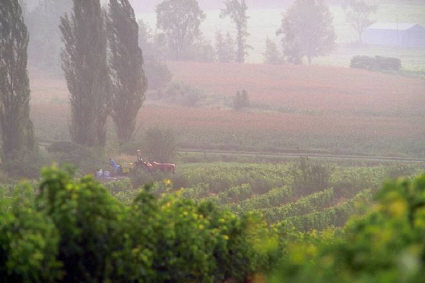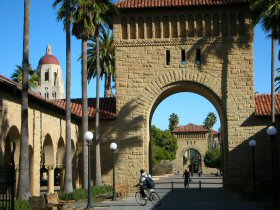Congratulations
to SEJ member
Lisa Mighetto of Seattle, WA, lucky winner of this year's free
conference registration! Lisa planned
ahead — for her registration, and
paid her membership dues on time to
qualify for entry to our annual raffle.
This could be YOU next year in Roanoke,
VA! Watch your membership dues
mailing for details and your chance to
win.
|
"For the greatest of the truly great, stick to California"
Some of the world's best outdoor adventures, natural features and getaways are in the Golden State. Tom Stienstra of the San Francisco Chronicle has
details, complete with lists of must-see lakes, hikes, fishing, rivers, camping, biking, rafting and more.
|
SEJ's 17th annual conference was hosted by Stanford University.
Conference-in-a-nutshell
menu
Agenda
Coverage
• About SEJ
• About Stanford University
• About Stanford's Woods Institute for the Environment
and John S. Knight Fellowships for Professional Journalists
• Area Attractions
•
Hospitality Receptions
•
Reporters Ride/Drive Participants, Exhibitors and Advertisers
•
Speakers
• www.sejarchive.org and SEJournal Advertising Opportunities
Westward Ho!
Where better to explore pioneering ideas on the environment than "a place of
innovation and experimentation?" That would be California, as journalist Carey
McWilliams coined it a generation ago. Learn how the Golden State leads the nation's charge against global warming,
be it changes in fuels, land use or building codes.
Where better to buttonhole so many sources? The San Francisco Bay Area brims with
environmental researchers, scientists, lawyers, philanthropists and activists.
Where better to envision than visionary central? Silicon Valley breeds not only
new media moguls but also developers of energy-saving technologies and other moneymaking
solutions to pollution. Pack an earful of optimism from these innovators and from your own peers who have
moved beyond hand-wringing over climate change, the environment beat and the news
industry.
Where better to converge than the heart of Silicon Valley? Stanford University,
one of the world's leading research and teaching institutions, is within an hour's drive of
San Francisco to the north, Oakland and Berkeley to the east and San Jose to the south. Roam the campus like a visiting scholar, courtesy of our conference host,
Stanford University.

|
|
"Ways of Wind and Wine: Making Energy and Wine Eco-Friendly," one of nine Thursday tours, will explore the Altamont Pass Wind Resource Area and vineyards such as these.
|
Where better to recharge the spirit in so many venues? Stanford puts you within
a day's round-trip drive of the Sacramento-San Joaquin River Delta, Wine Country,
Monterey Bay and the Salinas and Livermore valleys.
- See for yourself how lettuce and spinach are grown, harvested and processed.
- Smell the diesel-inundated neighborhoods around the Port of Oakland.
- Immerse in the redwoods of the Santa Cruz Mountains.
- Kayak a tidal salt marsh on the Central Coast.
- Dine on sustainable seafood at the Monterey Bay Aquarium.
- Ply the waters of the Delta, the largest estuary on the West Coast.
- Sample organic wines.
- Hike San Francisco.
Where better?
See you, in September!
Your 2007 Conference Co-Chairs,
P.S.
For details on
tours and the exciting, jam-packed
conference schedule, see our brochure (requires
free Adobe Acrobat ®
reader) or the conference agenda.
About the
Society of Environmental
Journalists
Founded in 1990, SEJ is a unique membership organization of working journalists. SEJ's mission is to advance
public understanding of environmental issues by improving the quality, accuracy and visibility of environmental
news reporting. SEJ is at the center of a growing community of individuals and institutions concerned with media
and the environment. SEJ supporters and its board, staff and membership of more than 1,300 journalists, educators
and students are dedicated to improving and increasing news coverage of environmental issues through programs
and services designed by and for journalists. We are building a stronger, better-educated, and more closely
connected network of journalists and editors in print, radio, television and online media who cover environment-related
issues.
SEJ programs include annual conferences,
a comprehensive Web site, TipSheet, SEJournal, EJToday daily news digest, Awards for Reporting on the
Environment, diversity program,
conference fellowships, mentoring program and the
freedom-of-information WatchDog project.
Financial support for SEJ's work is
provided by foundation grants, earned income
through dues and fees, media company contributions
and university sponsorship of the annual conference.
SEJ does not seek or accept gifts or grants from
non-media corporations, government agencies or
environmental groups. SEJ welcomes individual
gifts to its 21st Century Endowment
Fund.
Funding for SEJ programs and services
in 2007 has been provided by Stanford University (2007
conference host and primary sponsor), the William and Flora Hewlett Foundation, McCormick Tribune Foundation, Wallace Genetic Foundation, Turner Foundation, David and Lucile Packard Foundation, Park Foundation, Scripps Howard Foundation, and individual donors to the Society of
Environmental Journalists.
Back to the
Conference-in-a-nutshell menu
About Stanford University
Located between San Francisco and San Jose in the heart of the Silicon Valley, Stanford University offers extensive
opportunities for learning and research through seven schools: Graduate School of Business, Earth Sciences,
Education, Engineering, Humanities and Science, Law, and Medicine. The university is particularly noted for its focus
on interdisciplinary research as well as its historic strength in innovation and technology. Established by Leland and
Jane Stanford in memory of their son, Stanford opened its doors on Oct. 1, 1891. Today, the 8,000-acre campus is
home to 6,700 undergraduates and 8,100 graduate students.
Back to the
Conference-in-a-nutshell menu
About our conference co-hosts

|
|
Stanford campus photo courtesy of James Bruggers.
|
Woods Institute for the Environment
Among Stanford's interdisciplinary efforts is the campus-wide Initiative on the Environment and Sustainability. At
the core of the initiative, the Ward W. and Priscilla B.Woods Institute for the Environment at Stanford is a unifying
force and interdisciplinary hub for research, teaching and problem-solving that draws on the experience and expertise
of faculty and students from all seven schools.
John S. Knight Fellowships for Professional Journalists
This Stanford program offers journalists a year to study and reflect, away from newsroom deadline pressures, in the
company of other accomplished journalists. The program provides outstanding mid-career journalists the chance to
broaden and deepen their understanding of a changing world.
Back to the
Conference-in-a-nutshell menu
Area Attractions
Culture, innovation, experimentation. Where better to converge than Stanford University, at the hub of the San Francisco Bay Area? The 8,180-acre campus, two-thirds of which is open space, offers unique beauty and attractions. Tour the largest Rodin sculpture collection outside of Paris or the two-mile linear accelerator. Take a walk to the Dish, a radio telescope in the nearby foothills designed to scan distant planets and galaxies. Or visit the neighboring cities of Palo Alto and Menlo Park which boast theater companies, movie houses, boutiques and excellent restaurants.
An hour north, San Francisco offers everything from striking views of its skyline and the Golden Gate Bridge to superb cuisine, world-class museums, art galleries, bayfront parklands, Alcatraz Island and an ancient redwood forest. To the south, the San Jose area features the Tech Museum of Innovation, the Computer History Museum, the Intel Museum, NASA Ames Research Center and the Lick Observatory.
- "A garden in the sky," by Carl T. Hall of the San Francisco Chronicle, May 12, 2007, relates the planning and planting of a green, living roof on the new California Academy of Sciences museum in Golden Gate Park.
And no matter which direction you travel from the Bay Area, you're bound to find something rewarding. Forty-five minutes west of Stanford are the beaches of the Pacific Ocean. Two hours south of campus are Monterey, Carmel and the rugged Big Sur coastline. Four hours to the east you can explore Lake Tahoe and the Sierra Nevada. And the scenic wine country of Napa and Sonoma valleys is roughly two hours north of campus.
Back to the
Conference-in-a-nutshell menu
Note: Information about
selected past SEJ annual
conferences is also available.
The Society of
Environmental Journalists
P.O. Box 2492 Jenkintown, PA 19046
Telephone: (215) 884-8174 Fax: (215)
884-8175
sej@sej.org
© 1994
Society of Environmental Journalists
The SEJ logo is a registered trademark
® of the Society of Environmental
Journalists. Neither the logo nor
anything else from the sej.org domain may
be reproduced without written consent of
the Society of Environmental
Journalists. All graphics © 2007 SEJ and its licensors. All rights reserved.
|
 SEJ's 17th Annual Conference
SEJ's 17th Annual Conference